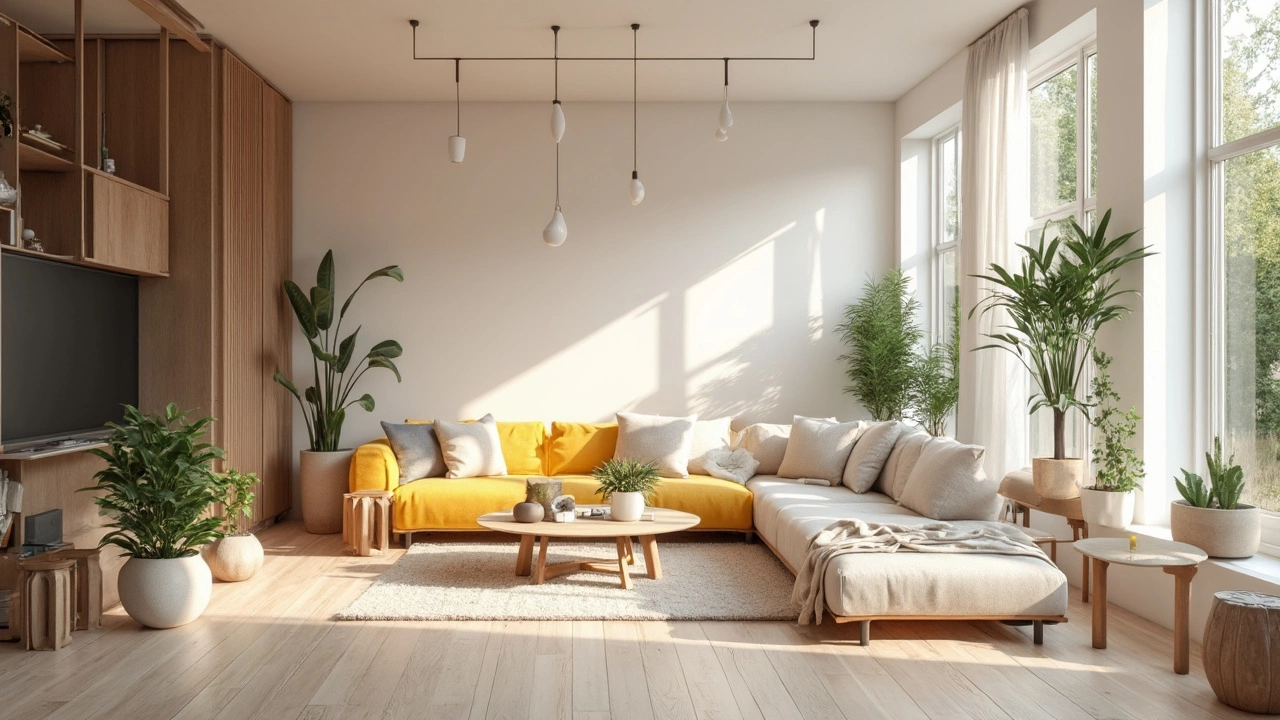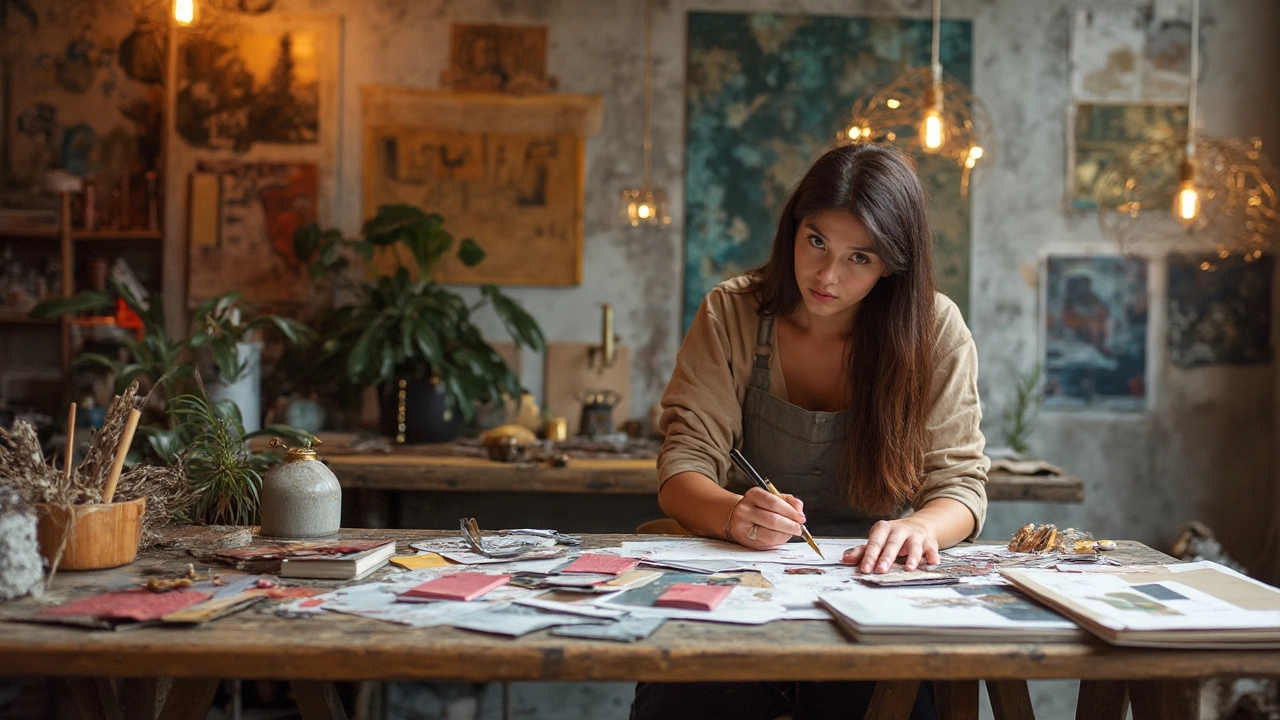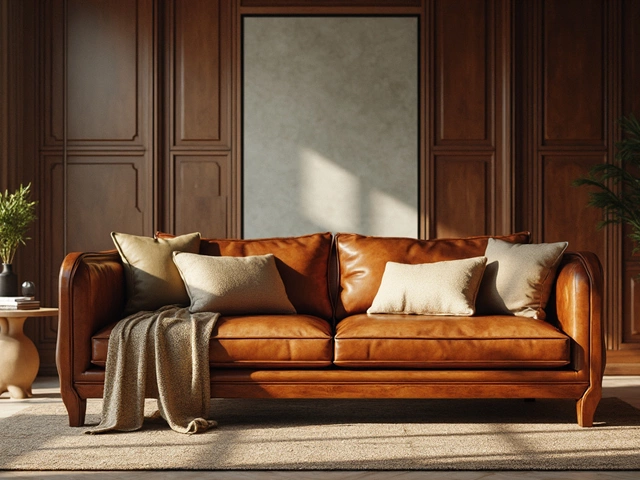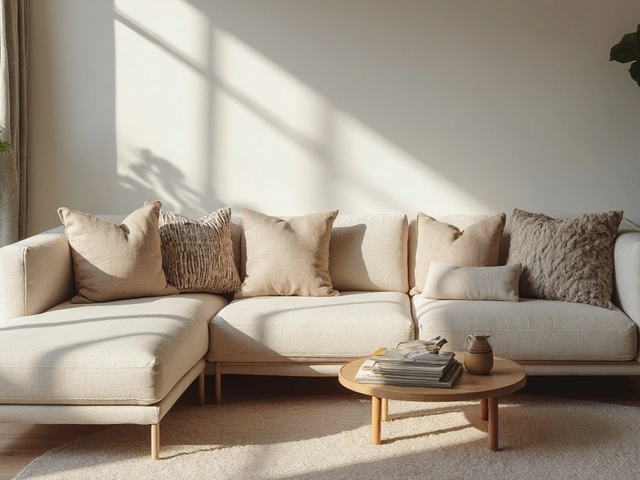
When it comes to modern interior design, knowing who to watch can make a world of difference. These top designers aren’t just creating beautiful spaces; they're redefining how we live and interact with our homes.
Take Kelly Wearstler, for example. She's known for her bold, eclectic style that combines luxury with edgy elements. Her spaces often feature unexpected patterns and textures. Want to try something bold at home? Wearstler's use of rich colors and striking materials could be your inspiration.
Then there's Jonathan Adler, who brings a playful, vibrant touch to interiors. His philosophy is all about 'happy chic,' which essentially means decorating with joy in mind. Think lots of colors and whimsical decor pieces that put a smile on your face. Perfect for pepping up any dull room.
- Introduction to Modern Interior Design
- Kelly Wearstler's Unique Style
- Jonathan Adler's Playful Approach
- Ilse Crawford's Human-Centric Designs
- Joanna Gaines' Rustic Charm
- Tips for Applying Modern Design Principles at Home
Introduction to Modern Interior Design
Modern interior design is all about creating spaces that blend aesthetics with functionality. It’s a style that emerged in the early 20th century and is characterized by clean lines, minimalism, and an open concept. What's cool about modern design is its focus on simplicity and the idea that form follows function. This isn't your granny's floral wallpaper or ornate chandeliers; it's sleek, efficient, and stylish.
One big name in modern home interiors is Bauhaus, a German art school that massively influenced design as we know it. Bauhaus emphasized using simple shapes and industrial materials, which are still major elements in modern interiors today. As the iconic designer Ludwig Mies van der Rohe put it, "Less is more."
"Good design is making something intelligible and memorable. Great design is making something memorable and meaningful." - Dieter Rams
In a modern home, you'll often see a neutral color palette. Think whites, grays, and earth tones. This neutral base allows you to add personality with pops of color in art or throw pillows. Plus, it makes rooms feel more open and airy. An interesting fact? Furniture often doubles as art—sculptural chairs or coffee tables aren't just functional, they're conversation starters.
Want to bring modern design into your home? Start by decluttering your space. Modern design loves minimalism, so keep only what you need or really love. Then, focus on getting the lighting just right. Natural light is a favorite in modern spaces, but you can also use floor lamps or ceiling fixtures to create a warm glow.
- Use neutral colors as your primary palette.
- Introduce bold accent pieces with a pop of color or interesting texture.
- Maximize on natural light and incorporate strategic artificial lighting.
By incorporating these elements, you can create spaces that aren’t just modern but also cozy and inviting. It’s all about balancing style with substance, making every element in your home serve a purpose beyond just looking pretty.
Kelly Wearstler's Unique Style
If you've ever set foot in a space designed by Kelly Wearstler, you've probably felt a mix of awe and inspiration. She's not one to settle for dull or ordinary. Kelly's known for her bold and eclectic approach, injecting life and energy into every corner of a home.
So, what exactly makes her style stand out in the world of modern home interiors? It's her fearless use of color and texture. Kelly loves to mix metallics with plush velvet or juxtapose rough concrete with smooth marble. It’s all about experimenting with contrasting materials to create something powerhouse.
The Power of Bold Colors
One of Wearstler's signature moves is her use of rich and daring colors. Think deep blues, fiery reds, and lush greens. But hey, it’s not just about splashing paint around. She carefully chooses colors to evoke different emotions and vibes in each space. It’s a thoughtful, almost intuitive process rooted in how she wants the room to make people feel.
Mixing Patterns and Textures
Kelly often surprises with her pattern choices. You might see geometric rugs paired with floral wallpapers, creating a movement that keeps eyes dancing throughout the room. This dynamic use of textiles is a signature of her interior design, and it helps to craft spaces that are anything but boring.
Unique Furniture and Decor
When it comes to furniture, Kelly doesn't just pick pieces that are functional. She chooses ones that double as statement art pieces. Imagine a sculptural chair that's as much about form as it is function, or a light fixture that's almost a conversation starter by itself.
Kelly Wearstler's designs are about more than just looking good—they're about creating spaces that tell a story, invite interaction, and stimulate creativity. If you're looking to shake up your decor game, taking cues from her bold approach could be just what your space needs.
Jonathan Adler's Playful Approach
Jonathan Adler is a name every design enthusiast should know. His approach towards interior design is anything but ordinary. Many of his spaces are painted with a cheerful vibe that just can't be ignored.
Happy Chic Philosophy
At the core of Adler's work is his ‘happy chic’ philosophy. It's all about infusing rooms with whimsy, color, and a sense of unexpected fun. He believes that your home should make you happy the moment you walk through the door.
Adler often incorporates elements like quirky sculptures, vibrant throw pillows, and offbeat furniture pieces that seem to have their own personality. His collections sometimes blur the line between home decor and pop art.
Design Tips from Adler
- Play with Colors: Don't shy away from bold colors. Adler often uses bright blues, pinks, and yellows to create energy-filled spaces.
- Mix Styles: Combine vintage pieces with contemporary decorations. This mix-and-match approach gives a dynamic yet cohesive look.
- Embrace Quirkiness: Adding an element of surprise — like an oversized penguin figurine or a bold pattern on a small rug — can bring a space to life.
Adler's Impact on Modern Home Interiors
Jonathan Adler's influence on modern home interiors is substantial. His pieces are sold across various stores worldwide, inspiring countless homeowners to embrace a more playful side of interior design.
| Store Type | Number of Locations |
|---|---|
| Flagship Stores | 5 |
| Partner Retailers | Over 30 |
Whether you’re just sprucing up a living room or embarking on a full-scale home makeover, adopting a few of Jonathan Adler's playful tricks can add a bit of fun and personality to your space.

Ilse Crawford's Human-Centric Designs
Ilse Crawford is a name that resonates with anyone interested in modern home interiors. Her approach stands out because it's not just about aesthetics—it's about how spaces feel. At the core of Crawford's philosophy is the principle that design should serve the human experience.
Design That Puts People First
Crawford emphasizes comfort, warmth, and the notion of 'home' as a refuge. She believes our surroundings deeply affect our emotions and well-being. So, how does she do it? Think soft lighting, natural materials, and an invitation to linger. Her designs often favor cozy nooks and relaxing atmospheres, offering an escape from life's chaos.
Creating Emotional Connections
Ilse Crawford doesn't just design spaces; she creates environments that encourage interaction and connection. Whether it’s the open-plan hotel lobbies she’s famous for or intimate home settings, her work invites conversation and engagement. To emulate this, consider using open shelving in the kitchen or communal tables that encourage mixing and mingling.
Impact on Public Spaces
Crawford's impact extends beyond private spheres. Public spaces like Stockholm's Ett Hem Hotel reflect her ethos. This hotel, in particular, is more like a welcoming home, rather than a sterile lodging. The use of plush textiles, inviting colors, and personalized details make guests feel genuinely at home.
Her design philosophy can be broken down into a few essential practices:
- Use of natural light to create warmth.
- Incorporation of tactile materials like wool, linen, and wood.
- Designing spaces that encourage relaxation and calmness.
Applying Crawford's Principles at Home
You don't need an architect's budget to bring Ilse's ideas into your own home. Start by decluttering to allow more light and space. Introduce materials that not only look good but feel good to the touch. Soft throws, wooden accents, and plants can make a substantial difference. Most importantly, focus on creating areas where family and friends can gather comfortably.
By focusing on human-centric design, Ilse Crawford teaches us that homes should not just be lived in, but experienced and enjoyed.
Joanna Gaines' Rustic Charm
Joanna Gaines has become a household name, especially for fans of the rustic-chic aesthetic. Known for her work on HGTV's Fixer Upper, Joanna has mastered the art of transforming old, often neglected spaces into cozy, inviting homes. Her signature style features elements like shiplap walls, vintage furniture, and neutral palettes. But there's more to her design magic than meets the eye.
Interior designers like Joanna have a knack for blending the old with the new. A typical Gaines home might feature distressed wood alongside modern metal light fixtures. This combination creates a warm, lived-in feel without sacrificing style. If you're into modern home interiors but want a touch of homeliness, this is the route to take.
Integrating Rustic Elements
One key to achieving Joanna's rustic charm is focusing on natural materials. Wood, cotton, and stone are staples. Her designs often include open shelving made from reclaimed wood, providing both function and aesthetics.
- Use shiplap or wood paneling on feature walls to add texture.
- Embrace a neutral color palette to create a serene backdrop.
- Accessorize with plants or vintage finds for a personalized touch.
The Impact of Personalization
What sets Joanna apart from other interior designers is her ability to personalize each project. She often incorporates pieces that have sentimental value to the homeowner, making the space uniquely theirs. It's a simple yet effective way to make a house feel like a home.
So, if you're thinking of giving your own home a rustic makeover, take a page from Joanna's book. Combine modern elements with rustic charm, and you'll have a space that feels both current and timeless.
Tips for Applying Modern Design Principles at Home
Bringing modern home interiors into your space can seem daunting, but it doesn’t have to be. With a focus on sleek lines, functional spaces, and minimal clutter, you can easily create a stylish home that fits your lifestyle. Here are some actionable tips to help you get started.
Embrace Open Layouts
The modern design often emphasizes open spaces. If possible, remove unnecessary walls to create a more fluid space between rooms. This not only makes your home feel larger but also allows for natural light to permeate the entire area.
Neutral Color Palette with a Pop
Modern interiors typically use neutral colors as a base. Whites, grays, and beiges work beautifully. But, don't shy away from adding a pop of color as an accent. Think a bright yellow pillow on a gray couch or a bold piece of art on a white wall.
Invest in Quality Furniture
Modern design is about quality over quantity. Invest in a few key pieces of furniture that speak to your personal style. Look for furniture with clean lines and simple forms without excessive ornamentation.
Incorporate Technology
In today's world, tech integration is a hallmark of modern design. Consider smart lighting and automated blinds. Not only do these elements provide convenience, but they also add a modern touch to your home.
Lighting Matters
Lighting is crucial in modern design. Use a mix of ambient, task, and accent lighting to create a well-lit space. Track lighting, pendant lights, and large windows can all add to the ambiance of a modern home.
Declutter and Simplify
Modern interiors shine best without clutter. Adopt a 'less is more' attitude and remove items that don’t serve a purpose. When choosing decor items, opt for those with a functional edge.
| Insight | Impact |
|---|---|
| Open layouts | Leads to improved air circulation and greater energy efficiency |
| Smart technology | Reduces energy consumption by up to 30% |
Remember, the goal is to create a space that's both stylish and functional. Every element should serve a purpose and contribute to the overall aesthetic. By following these principles, you'll be well on your way to achieving a modern, chic home that you love.



